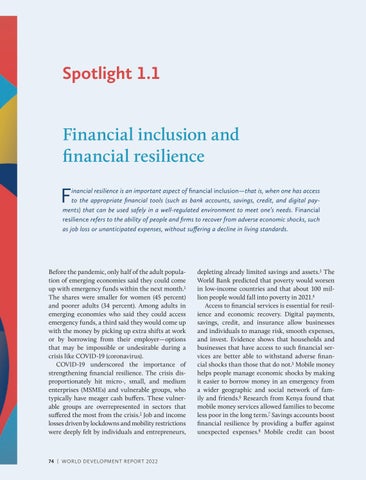Spotlight 1.1 Financial inclusion and financial resilience
F
inancial resilience is an important aspect of financial inclusion—that is, when one has access to the appropriate financial tools (such as bank accounts, savings, credit, and digital payments) that can be used safely in a well-regulated environment to meet one’s needs. Financial resilience refers to the ability of people and firms to recover from adverse economic shocks, such as job loss or unanticipated expenses, without suffering a decline in living standards.
Before the pandemic, only half of the adult population of emerging economies said they could come up with emergency funds within the next month.1 The shares were smaller for women (45 percent) and poorer adults (34 percent). Among adults in emerging economies who said they could access emergency funds, a third said they would come up with the money by picking up extra shifts at work or by borrowing from their employer—options that may be impossible or undesirable during a crisis like COVID-19 (coronavirus). COVID-19 underscored the importance of strengthening financial resilience. The crisis disproportionately hit micro-, small, and medium enterprises (MSMEs) and vulnerable groups, who typically have meager cash buffers. These vulnerable groups are overrepresented in sectors that suffered the most from the crisis.2 Job and income losses driven by lockdowns and mobility restrictions were deeply felt by individuals and e ntrepreneurs,
74 | WORLD DE VELOPMENT REPORT 2022
depleting already limited savings and assets.3 The World Bank predicted that poverty would worsen in low-income countries and that about 100 million people would fall into poverty in 2021.4 Access to financial services is essential for resilience and economic recovery. Digital payments, savings, credit, and insurance allow businesses and individuals to manage risk, smooth expenses, and invest. Evidence shows that households and businesses that have access to such financial services are better able to withstand adverse financial shocks than those that do not.5 Mobile money helps people manage economic shocks by making it easier to borrow money in an emergency from a wider geographic and social network of family and friends.6 Research from Kenya found that mobile money services allowed families to become less poor in the long term.7 Savings accounts boost financial resilience by providing a buffer against unexpected expenses.8 Mobile credit can boost

